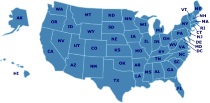Geology
Rocks and minerals can be found in your own backyard. Explore the world around you and learn about the history of the formation of the Earth by studying geology. We've gathered resources to make it fun and interesting.
Things to See & Do in Montana
Bighorn Canyon National Recreation Area
Bighorn Lake extends approximately 60 miles through Wyoming and Montana, 55 miles of which are held within spectacular Bighorn Canyon. The Recreation Area is composed of 70,000+ acres, which straddles the northern Wyoming and southern Montana borders. There are two visitor centers and other developed facilities in Fort Smith, Montana and near Lovell, Wyoming. The Afterbay Lake below the Yellowtail Dam is a good spot for trout fishing and wildlife viewing for ducks, geese and other animals. The Bighorn River below the Afterbay Dam is a world class trout fishing area. Bighorn Canyon National Recreation Area is a lesser known treasure waiting to be discovered. It boasts breath-taking scenery, countless varieties of wildlife, and abundant recreational opportunities, such as boating, fishing, ice fishing, camping, and hiking. Bighorn Canyon offers visitors what few other National Park areas can, that of solitude, serenity, and beauty.
Museum of the Rockies
The Museum of the Rockies is the largest natural history museum in the region with 94,000 square feet under roof. It includes the only Digistar planetarium in the Northern Rockies and has developed a fully interpreted Living History Farm on 11 adjacent acres. Exhibits include the Hall of Horns and Teeth, One Day 80 Million Years Ago, the Bowman Fossil Bank, Enduring Peoples, Montana on the Move, the Martin Discovery Room, and many temporary exhibits. The museum is located on the south side of the Montana State University campus in Bozeman.
Glacier National Park
Glacier preserves over 1,000,000 acres of forests, alpine meadows, and lakes. Its diverse habitats are home to over 70 species of mammals and over 260 species of birds. The spectacular glaciated landscape is a hikers paradise containing 700 miles of maintained trails that lead deep into one of the largest intact ecosystems in the lower 48 states. The park contains over 350 structures listed on the National Register of Historic Sites and six National Historic Landmarks.
Yellowstone National Park
About 640,000 years ago a massive volcanic eruption spewed an immense volume of ash that covered all of the western U.S., much of the Midwest, northern Mexico and some areas of the eastern Pacific. This was one of many processes that shaped Yellowstone National Park--a region once rumored to be "the place where hell bubbles up." Geothermal wonders, such as Old Faithful, are evidence of one of the world's largest active volcanoes. These spectacular features bemused and befuddled the park's earliest visitors, and helped lead to the creation of the world's first national park.
World Museum of Mining and Hell Roarin' Gulch
This 44-acre museum in Butte, Montana, preserves more than a century of American history and brings it to life. Explore more than 50 structures, ranging from the 100-foot-high headframe of the Orphan Girl Mine to a faithful recreation of a mining town, Hell Roarin' Gulch. Half of the displays focus on the cultural and ethnic history of an 1880s to 1920s mining town, while the other half provides you with a detailed look at the history of mining technology. As one of very few museums to occupy an actual historic mine site, they are uniquely able to portray the story of mining from earliest methods to modern techniques.
Featured Resources
As an Amazon Associate, we earn from qualifying purchases. We get commissions for purchases made through links on this site.
Unclutter Your Home: 7 Simple Steps, 700 Tips & Ideas (Simplicity Series)
Hundreds of practical ideas for sorting, evaluating, and getting rid of all those material items that get in the way of a simplified lifestyle.
Please Don't Drink the Holy Water
Susie Lloyd faces the trials and joy of raising a happy, active Catholic family.
Pattern Blocks and Boards
This set of 10 simply designed colorful wooden blocks and pattern boards includes 100 blocks in six different shapes and colors. They help develop shape recognition and spatial relationship skills. The contents store neatly in a durable wooden case. This games was awarded the Scholastic Parent & Child's 2004 "Top 22 Toys that Make Kids Think" award.
Field Trips: Bug Hunting, Animal Tracking, Bird-watching, Shore Walking
With Jim Arnosky as your guide, an ordinary hike becomes an eye-opening experience. He'll help you spot a hawk soaring far overhead and note the details of a dragonfly up close. Study the black-and-white drawings -- based on his own field research -- and you'll discover if those tracks in the brush were made by a deer or a fox.In his celebrated style, this author, artist, and naturalist enthusiastically shares a wealth of tips. Jim Arnosky wants you to enjoy watching wildlife. He carefully expla...
Not So Fast: Parenting Your Teen Through the Dangers of Driving
Most driving literature for parents focuses on how to teach a teen to drive, without explaining why teen driving is so dangerous in the first place or giving parents a plan to preempt the hazards teens face. By contrast, Not So Fast empowers and guides parents to understand the causes and situations that most often lead to teen crashes and to take specific, proactive steps—before and each time a teen driver gets behind the wheel—to counteract them. This authoritative guide tackles hot button iss...





